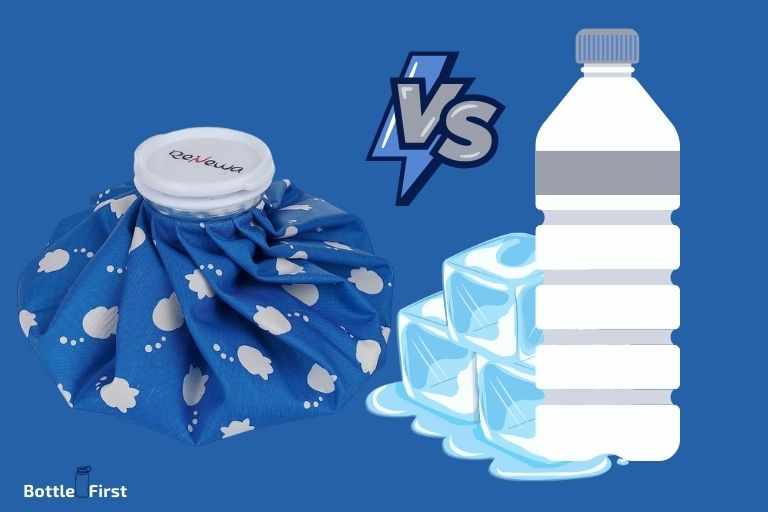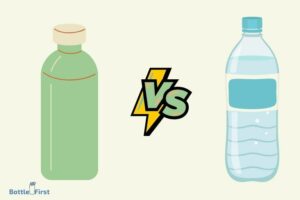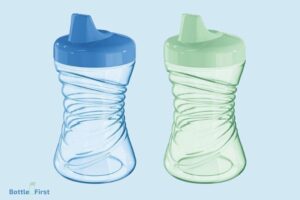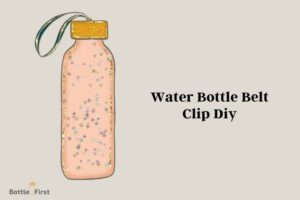Ice Pack Vs Frozen Water Bottle: Which One Is Better!
While both an ice pack and a frozen water bottle can provide cold therapy, an ice pack is generally more versatile and convenient due to its flexible nature and even temperature distribution.
Ice packs are specifically designed for cold therapy, which makes them ideal for reducing inflammation and swelling caused by injuries.
They are flexible, allowing them to mold to the shape of the body part they are cooling, providing even temperature distribution.
On the other hand, while a frozen water bottle can provide cold therapy, it may not conform to the body as well. It can be used effectively for specific applications like rolling under the foot for plantar fasciitis.
In summary, while a frozen water bottle can provide some relief, an ice pack is generally a better option for cold therapy.
An ice pack’s ability to flex and mold to the body allows for more effective and even distribution of cold, making it more efficient at reducing inflammation and swelling.
Comparison of Ice Pack vs Frozen Water Bottle
| Feature | Ice Pack | Frozen Water Bottle |
|---|---|---|
| Temperature | Stays cold for longer periods | Melts faster, not as cold |
| Convenience | Easy to wrap around an injury | Harder to manipulate around a specific area |
| Portability | More portable due to compact size | Bulky, could be heavy depending on size |
| Safety | Designed for the body, safe for use | Can cause frostbite if applied directly to the skin |
| Durability | Made to last, reusable | Bottle could crack in the freezer |
| Cost | Usually more expensive | Less expensive, especially if you already have a bottle |
| Environmental Impact | Can be high if not made from recyclable material | Lower if the bottle is reused |
Key Takeaway

Five Facts About Ice Pack & Frozen Water Bottle
Understanding The Purpose Of Cold Therapy
Importance Of Cold Therapy In Managing Pain And Inflammation
Cold therapy, also known as cryotherapy, is a widely used method for managing pain and inflammation in various medical conditions.
Whether it’s a sports injury, post-operative swelling, or a nagging headache, cold therapy can provide significant relief.
Here’s why it’s important:
- Reduces inflammation: Cold therapy constricts blood vessels, thereby reducing blood flow to the affected area. This helps in reducing inflammation and swelling, which are often the root causes of pain.
- Relieves pain: By numbing the area and slowing down nerve impulses, cold therapy effectively reduces pain sensations. This is especially helpful for acute injuries or chronic conditions that cause persistent pain.
- Speeds up healing: Cold therapy promotes faster healing by boosting the metabolic rate and increasing cellular activity. This not only helps in repairing damaged tissues but also aids in reducing scar formation.
- Minimizes muscle spasms: Muscle spasms can be painful and hinder the recovery process. Applying cold therapy helps relax the muscles, reducing the likelihood of spasms and allowing for better mobility.
- Eases migraines and headaches: Cold packs applied to the head or neck can alleviate migraines and tension headaches. The cold temperature helps to constrict blood vessels and decrease the release of pain-inducing chemicals in the brain.
Factors To Consider When Choosing A Cold Therapy Method
When it comes to utilizing cold therapy, there are different options available, each with its own advantages.
Consider the following factors to determine the most suitable cold therapy method:
Convenience:
Depending on your needs, you might prefer an ice pack or a frozen water bottle. Ice packs are readily available, can be used multiple times, and can cover a larger area. On the other hand, frozen water bottles are portable and can offer targeted relief.
Duration of application:
The duration for which you need to apply cold therapy can influence your choice. Ice packs typically provide relief for 15-20 minutes at a time, while frozen water bottles may last longer due to their slower melting rate.
Sensitivity to cold:
Some individuals may have a higher sensitivity to cold temperatures. If you’re sensitive, it might be wise to opt for a method that allows for a barrier between the skin and the cold source, such as wrapping the ice pack in a cloth or using a thin towel with a frozen water bottle.
Size and shape of the affected area:
Consider the size and shape of the area requiring cold therapy. Ice packs are versatile and can be molded or wrapped around various body parts. Alternatively, a frozen water bottle can be rolled or pressed against specific areas.
Personal preference:
Ultimately, personal preference plays a key role in choosing the most suitable cold therapy method.
Whether it’s the soothing sensation of an ice pack’s gel or the easy applicability of a frozen water bottle, select the option that feels most comfortable for you.
Remember, cold therapy is generally safe and effective when used properly. However, if you have circulatory issues, cold allergies, or any pre-existing medical conditions, consult with a healthcare professional before applying cold therapy.
The Benefits Of Using Ice Packs
Ice packs are a popular choice for alleviating pain and reducing swelling, and for good reason. Here are some key benefits of using ice packs:
Effectiveness Of Ice Packs In Reducing Pain And Swelling
- Ice packs provide immediate relief by numbing the affected area and reducing inflammation.
- The cold temperature of ice packs helps to constrict blood vessels, reducing blood flow and minimizing swelling.
- Ice packs can effectively reduce pain caused by various conditions, such as sprains, strains, muscle soreness, and joint pain.
- Applying ice packs to the affected area can help prevent further tissue damage and speed up the healing process.
Ease Of Use And Convenience Offered By Ice Packs
- Ice packs are incredibly easy to use and require no special training or equipment.
- They come in various shapes and sizes, making it possible to target specific areas of the body.
- Ice packs can be easily stored in the freezer and are ready for use whenever needed.
- They are portable and can be taken on the go, making them convenient for use during sports activities or while traveling.
Different Types Of Ice Packs Available In The Market
- Gel-filled ice packs are a common choice as they provide flexible and reusable cooling options.
- Disposable ice packs are pre-filled with water or gel and are convenient for one-time use.
- Instant ice packs contain chemicals that, when activated, create an instant cooling effect without the need for refrigeration.
- Wrap-around ice packs are designed to conform to the body’s shape, providing targeted relief.
Using ice packs has several advantages, including their effectiveness in reducing pain and swelling, their ease of use and convenience, and the availability of different types to suit individual needs.
Whether you’re dealing with a minor injury or a chronic condition, ice packs can be a valuable tool in managing discomfort.
So, next time you’re in need of some cool relief, consider reaching for an ice pack.
Exploring The Use Of Frozen Water Bottles
Ice packs and frozen water bottles are popular choices for cold therapy, but have you ever considered using frozen water bottles specifically?
When it comes to relieving pain and reducing inflammation, frozen water bottles offer their own unique benefits.
In this section, we will delve into the advantages of using frozen water bottles for cold therapy, including their accessibility and affordability as a cooling agent.
Additionally, we will discuss the proper techniques for using frozen water bottles effectively. So, let’s jump right in!
Comparing The Benefits Of Using Frozen Water Bottles For Cold Therapy
Using frozen water bottles for cold therapy can have several advantages over traditional ice packs.
Here are a few key points to consider:
Longer-lasting coldness:
Frozen water bottles have the ability to stay cold for a longer period of time compared to traditional ice packs. This prolonged cooling effect can be particularly beneficial for certain types of injuries or post-workout recovery.
More targeted relief:
The cylindrical shape of a frozen water bottle allows for targeted application of cold therapy to specific areas of the body.
Whether you’re dealing with a muscle strain or a swollen joint, using a frozen water bottle enables you to provide focused relief exactly where it’s needed.
Versatility:
Apart from using frozen water bottles for cold therapy, they can also be used as a makeshift ice pack when needed. You can fill up a bottle with cold water or even add some ice cubes for a quick cooling solution on the go.
Accessibility And Affordability Of Frozen Water Bottles As A Cooling Agent
One of the major advantages of using frozen water bottles is their accessibility and affordability. Consider the following points:
Easy availability:
A frozen water bottle can be easily obtained by simply placing a filled water bottle in the freezer. This makes it a convenient option for anyone, without the need for specialized equipment or supplies.
Cost-effective solution:
Using frozen water bottles can be a cost-effective way to incorporate cold therapy into your routine. Unlike some ice packs, which may require purchasing or replacing gel inserts, frozen water bottles can be used repeatedly without any additional expenses.
Portable and convenient:
Frozen water bottles are portable, making them ideal for on-the-go use. Whether you’re at the gym or away from home, you can simply bring along a frozen water bottle to have an instant cooling agent readily available whenever needed.
Proper Techniques For Using Frozen Water Bottles Effectively
To ensure maximum effectiveness and safety when using frozen water bottles for cold therapy, follow these tips:
- Wrap the frozen water bottle in a thin towel or cloth before applying it to the skin. This helps to protect your skin from direct contact with the cold surface and prevents any potential ice burns or discomfort.
- Apply the frozen water bottle to the affected area for 15-20 minutes at a time. Allow an adequate resting period between applications to prevent overexposure to cold temperatures.
- Avoid placing excessive pressure on the frozen water bottle while applying it to your body. Gentle, circular motions can help enhance the cooling effect without causing discomfort.
By utilizing frozen water bottles for cold therapy, you can take advantage of their unique benefits, accessibility, and affordability. Whether you’re in need of targeted relief or a convenient cooling solution on the go, frozen water bottles can be a valuable addition to your cold therapy routine.
Evaluating The Pros And Cons
Cold therapy is a common method used to relieve pain, reduce swelling, and promote healing after an injury or surgery. Two popular options for cold therapy are ice packs and frozen water bottles.
While both can effectively provide the desired cooling effect, there are distinct advantages and disadvantages to consider.
In this section, we will explore the pros and cons of using ice packs and frozen water bottles, as well as the factors to consider when deciding between the two.
Advantages And Disadvantages Of Using Ice Packs For Cold Therapy
Using ice packs for cold therapy offers several benefits, but it also comes with a few drawbacks. Let’s take a closer look:
Advantages:
- Convenient and reusable: Ice packs can be conveniently stored in the freezer and reused multiple times.
- Targeted relief: The design of ice packs allows for better placement on specific areas of the body, providing targeted relief.
- Controllable temperature: Ice packs typically have adjustable straps or wraps that allow for temperature control and prevent direct contact with the skin, avoiding potential ice burns.
- Reduced mess: Ice packs are a cleaner option as they don’t melt like frozen water bottles, minimizing the risk of wetness and discomfort.
Disadvantages:
- Limited coverage: Depending on the size of the ice pack, it may not cover larger areas of the body as effectively as a frozen water bottle.
- Rigidity: Ice packs tend to be more rigid, making them less versatile for molding around body contours.
- Initial discomfort: Applying an ice pack directly to the skin may cause initial discomfort due to the cold temperature.
Pros And Cons Of Utilizing Frozen Water Bottles As An Alternative Cooling Method
Frozen water bottles provide an alternative to ice packs for cold therapy. Let’s explore the advantages and disadvantages of using frozen water bottles:
Pros:
- Cost-effective: Frozen water bottles are easily accessible and inexpensive, making them a budget-friendly option for cold therapy.
- Versatile coverage: The cylindrical shape of a frozen water bottle allows for broader coverage, ideal for larger body areas.
- Customizable shape: Frozen water bottles can be molded to fit the contours of the body, providing a better fit and enhanced comfort.
- Long-lasting: Frozen water bottles tend to stay cold for longer durations compared to some ice packs.
Cons:
- Risk of leakage: As frozen water bottles melt, they can leak water, leading to potential wetness and discomfort during the treatment.
- Limited reusability: Frozen water bottles may need to be refrozen before each use, which can be less convenient and time-consuming.
- Hygiene concerns: If not properly cleaned, frozen water bottles can accumulate bacteria or other contaminants, posing a risk of infection.
Factors To Consider When Deciding Between Ice Packs And Frozen Water Bottles
When choosing between ice packs and frozen water bottles for cold therapy, several factors should be taken into account:
- Size: Consider the size of the area you want to cover and choose the option that provides adequate coverage.
- Comfort: Take into consideration your comfort level with each method. Some individuals may prefer the flexibility of a frozen water bottle, while others may opt for the targeted relief of an ice pack.
- Convenience: Evaluate the convenience of each option, including storage space availability, reusability, and ease of use.
- Hygiene: If hygiene is a concern, take note of the cleaning requirements for both ice packs and frozen water bottles.
- Safety: Ensure that the chosen method does not pose any risk of injury, such as potential ice burns or leakage.
By analyzing the advantages and disadvantages of ice packs and frozen water bottles, as well as considering individual preferences and specific needs, you can make an informed decision on which cooling method to choose for your cold therapy.
Conclusion: Choosing The Right Cold Therapy Method
Ice Pack Vs Frozen Water Bottle
Using cold therapy to alleviate pain and reduce swelling is a common practice for many individuals.
But when it comes to choosing the right cold therapy method, there are a few factors to consider. Should you opt for the traditional ice pack or try using a frozen water bottle instead?
Let’s explore the pros and cons of each to help you make an informed decision.
Factors To Consider When Determining The Most Suitable Cold Therapy Method For Your Needs:
Convenience:
Ice packs are readily available in the market and can be stored in the freezer for instant use. On the other hand, frozen water bottles can be easily made at home by placing water-filled bottles in the freezer.
Temperature control:
Ice packs are specifically designed to provide a consistent cold temperature, ensuring effective pain relief. Frozen water bottles, on the other hand, may have varying levels of coldness depending on the water content and freezing time.
Shape and size:
Ice packs usually come in various shapes and sizes to fit different body parts. They can be molded to conform to the affected area, providing targeted relief. Frozen water bottles, however, have a fixed cylindrical shape that may not be as versatile or adaptable.
Longevity:
Ice packs generally retain their coldness for a longer duration compared to frozen water bottles. The gel or liquid inside the ice packs takes longer to thaw, providing a more extended period of cold therapy. Frozen water bottles tend to lose their coldness relatively quickly.
Reusability:
Ice packs can be reused multiple times, making them a cost-effective choice. They can be refrozen and used again whenever needed. Frozen water bottles, on the other hand, may not be as reusable. As the ice melts, the bottle loses its shape and effectiveness.
Final Thoughts On The Effectiveness And Practicality Of Ice Packs Versus Frozen Water Bottles:
Both ice packs and frozen water bottles can offer relief from pain and swelling when used correctly.
Ultimately, the choice between the two comes down to personal preference and the specific requirements of your situation.
Ice packs provide convenience, consistent coldness, versatility, and longer-lasting cold therapy. They are particularly beneficial for athletes, individuals with chronic pain, and those who require frequent cold therapy.
On the other hand, frozen water bottles are a diy alternative that can be effective in less severe situations or when immediate access to an ice pack is not possible.
Consider your needs and the factors mentioned above when deciding which cold therapy method to use. It’s always a good idea to consult with a healthcare professional for personalized advice based on your specific condition.
Remember, the goal is to alleviate pain and promote healing, so choose the option that works best for you.
How Does Supercooling Work and Why Does a Cold Water Bottle Turn to Ice?
Supercooling is the fascinating process through which a cold water bottle becomes ice. When water is cooled below its freezing point without any disturbance, it remains liquid until a trigger, like a slight movement or impurity, prompts ice crystal formation. This rapid shift occurs due to an imbalance of energy, leading to the transformation from liquid to a solid state.
FAQ About Ice Pack Vs Frozen Water Bottle
Can I Use An Ice Pack Instead Of A Frozen Water Bottle For Pain Relief?
Yes, using an ice pack can be just as effective for pain relief as using a frozen water bottle.
What Are The Advantages Of Using A Frozen Water Bottle Over An Ice Pack?
Using a frozen water bottle provides targeted relief, conforms to body contours, and can be used for massage.
Can A Frozen Water Bottle Stay Cold Longer Than An Ice Pack?
Yes, a frozen water bottle can stay cold longer due to its insulated design and the slower melting rate of ice.
Is It Safe To Use A Frozen Water Bottle Directly On The Skin?
It is recommended to wrap the frozen water bottle in a towel before using it on the skin to prevent skin damage.
Are There Any Specific Benefits Of Using An Ice Pack Over A Frozen Water Bottle?
Ice packs are more convenient, reusable, and can cover larger areas of the body for pain relief.
Conclusion
Both ice packs and frozen water bottles serve the purpose of providing relief for various injuries and ailments.
While ice packs offer the advantage of being reusable and specifically designed for therapeutic use, frozen water bottles can be a convenient alternative in situations where ice packs are not available.
However, it is important to note that frozen water bottles may not provide the same level of flexibility and targeted cold therapy as ice packs.
Considering factors such as portability, ease of use, and effectiveness, individuals should choose the option that best suits their needs.
Whether it’s a sore muscle or a hot day, both ice packs and frozen water bottles can offer soothing relief.
So, the next time you need a cold compress, make an informed decision based on your preferences and the specific situation at hand.
Stay cool and healed!






